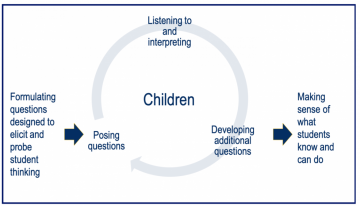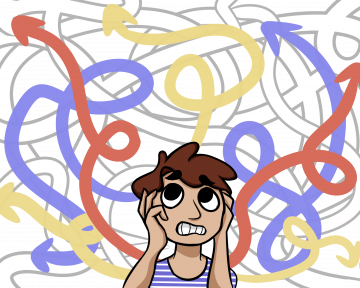What is eliciting students’ thinking?
According to Teaching Works Team (2022, May 9), eliciting students’ thinking involves classroom practices that develop, interpret, and access student thinking, such as questioning, discussions, and assessments with the purpose of identifying students’ prior knowledge, understanding, and misconceptions. It is a pedagogical approach where…

“Teachers pose questions that create space for students to share their thinking about specific academic content. They seek to understand student thinking, including novel points of view, new ideas, ways of thinking, or alternative conceptions. Teachers draw out student thinking through carefully chosen questions and tasks and attend closely to what students do and say. They consider and check alternative interpretations of student ideas and methods. Teachers are attentive to how students might hear their questions and to how students communicate their own thinking. Teachers use what they learn about students to guide instructional decisions and to surface ideas that will benefit other students. By eliciting and interpreting student thinking, the teacher positions students as sense-makers and centers their thinking as valuable” (Teaching Works Team, 2022, May 9).
Why is eliciting student thinking essential?
 There are many reasons to teachers invest classroom time to elicit students’ thinking:
There are many reasons to teachers invest classroom time to elicit students’ thinking:
- Value students’ ideas, competencies, and ways of seeing the world, changing the focus from the teacher to the students;
- Understand students’ connections to previous knowledge, making learning meaningful;
- support students’ deepen understanding of essential concepts in each subject matter, generating the development of high-level skills;
How can teachers elicit student thinking?
The Teaching Works Team (2022, May 9) suggests some steps teachers can take to develop, interpret, elicit, or assess students’ thinking:
- “Formulating and posing questions designed to elicit and probe student thinking, with sensitivity to how students might hear or respond to the questions
- Listening to and interpreting student responses
- Developing additional questions, prompts, and tasks to probe and unpack what students say”
To help you understand the specific features in each one of the steps of this cycle, you can check in the Teaching Works Team document.

Source: Visual representation of eliciting and interpreting student thinking (Teaching Works Team, 2022, May 9).
Designing effective questions
Making questions to students is one of the most common and powerful pedagogical strategies used by teachers during the process of teaching and learning. Questions can bring benefits to both teachers and students. You can learn more about how to make good questions here.
Probing as a formative assessment
Another way that teachers can interpret students’ understanding is through formative assessment probes. Tobey and Arline’s books (2014) give many examples of how teachers can build formative assessment probes to identify misconceptions or prior knowledge that conducted students to develop their current way of thinking about specific contents or concepts in a subject area.
 The difference between using assessment probes to evaluate learning and to understand students’ thoughts, is that the latter wants to reveal parts of the learning process and not its final results. In this sense, the goal is to uncover the connections students have made during their learning. Another feature is that these types of formative assessment probes are designed to show students’ understanding of specific (and in general essential) knowledge of a subject. For example, Tobey and Arline (2014c, p. 5-7) claim that teachers should design assessments that allow uncovering students’ misconceptions about “area” and “volume”.
The difference between using assessment probes to evaluate learning and to understand students’ thoughts, is that the latter wants to reveal parts of the learning process and not its final results. In this sense, the goal is to uncover the connections students have made during their learning. Another feature is that these types of formative assessment probes are designed to show students’ understanding of specific (and in general essential) knowledge of a subject. For example, Tobey and Arline (2014c, p. 5-7) claim that teachers should design assessments that allow uncovering students’ misconceptions about “area” and “volume”.
As a consequence of better understanding students’ thinking, teachers may be able to design new learning experiences to deepen or correct students’ conception at this point. Therefore, teachers may be able to improve the process of teaching and learning and deepen students’ understanding.
What does eliciting students’ thinking look like in each content area?
 Teaching Works Team (2022, May 9) from the teacher education program of the University of Michigan has many specific tips and classroom resources for different subjects:
Teaching Works Team (2022, May 9) from the teacher education program of the University of Michigan has many specific tips and classroom resources for different subjects:
More resources:
The course below brings many classroom videos as examples of how to elicit students’ thinking. The videos discuss classroom situations and show how teachers can use these moments to better understand students’ thinking:
University of Michigan:
Below there are some examples of Formative Assessment Probes in different subject areas:
References:
Keeley, P., Eberle, F., & Farrin, L. (2005). Formative Assessment Probes: Uncovering Students’ Ideas in Science. Science Scope, 28(4), 18-21. http://pal.lternet.edu/docs/outreach/educators/education_pedagogy_research/assessment_probes_uncovering_student_ideas.pdf
NSTA (2022, May 9).Using Formative Assessment Probes With Real or Virtual Field Trips. https://www.nsta.org/science-and-children/science-and-children-septemberoctober-2020/using-formative-assessment-probes.
Ok Math Teachers (2022, May 9). Formative Assessment Probes. http://okmathteachers.com/formative-assessment-probes/
Teaching Works (2022, May 9). Eliciting and interpreting. The University of Michigan. https://library.teachingworks.org/curriculum-resources/teaching-practices/eliciting-and-interpreting/
Tobey, C., & Arline, C. (2014a). Uncovering student thinking about mathematics in the common core, grades k-2. SAGE Publications, Inc.
Tobey, C., & Arline, C. (2014b). Uncovering student thinking about mathematics in the common core, grades 3-8. SAGE Publications, Inc.
Tobey, C., & Arline, C. (2014c). Uncovering student thinking about mathematics in the common core, grades 6-8. SAGE Publications, Inc.
Tobey, C., & Arline, C. (2014d). Uncovering student thinking about mathematics in the common core, high school. SAGE Publications, Ltd.
Guest post by Peer Tutor Ariane Faria dos Santos (Ph.D. EDCP), Aug. 2022.

